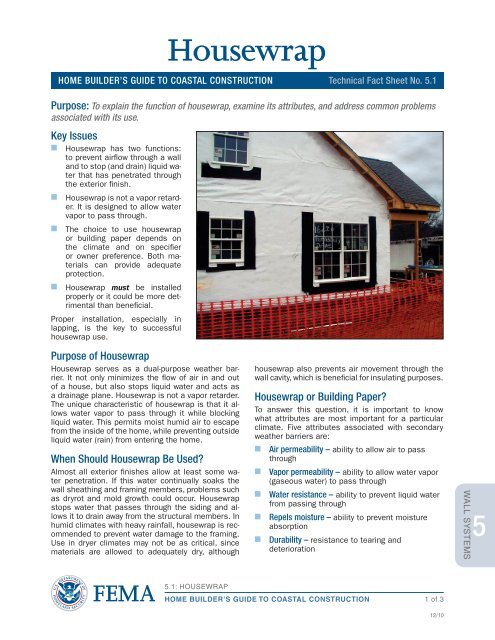FEMA P-499: Home Builder's Guide to Coastal Construction
FEMA P-499: Home Builder's Guide to Coastal Construction
FEMA P-499: Home Builder's Guide to Coastal Construction
You also want an ePaper? Increase the reach of your titles
YUMPU automatically turns print PDFs into web optimized ePapers that Google loves.
Housewrap<br />
HOME BUILDER’S GUIDE TO COASTAL CONSTRUCTION Technical Fact Sheet No. 5.1<br />
Purpose: To explain the function of housewrap, examine its attributes, and address common problems<br />
associated with its use.<br />
Key Issues<br />
n Housewrap has two functions:<br />
<strong>to</strong> prevent airflow through a wall<br />
and <strong>to</strong> s<strong>to</strong>p (and drain) liquid water<br />
that has penetrated through<br />
the exterior finish.<br />
n Housewrap is not a vapor retarder.<br />
It is designed <strong>to</strong> allow water<br />
vapor <strong>to</strong> pass through.<br />
n The choice <strong>to</strong> use housewrap<br />
or building paper depends on<br />
the climate and on specifier<br />
or owner preference. Both materials<br />
can provide adequate<br />
protection.<br />
n Housewrap must be installed<br />
properly or it could be more detrimental<br />
than beneficial.<br />
Proper installation, especially in<br />
lapping, is the key <strong>to</strong> successful<br />
housewrap use.<br />
Purpose of Housewrap<br />
Housewrap serves as a dual-purpose weather barrier.<br />
It not only minimizes the flow of air in and out<br />
of a house, but also s<strong>to</strong>ps liquid water and acts as<br />
a drainage plane. Housewrap is not a vapor retarder.<br />
The unique characteristic of housewrap is that it allows<br />
water vapor <strong>to</strong> pass through it while blocking<br />
liquid water. This permits moist humid air <strong>to</strong> escape<br />
from the inside of the home, while preventing outside<br />
liquid water (rain) from entering the home.<br />
When Should Housewrap Be Used?<br />
Almost all exterior finishes allow at least some water<br />
penetration. If this water continually soaks the<br />
wall sheathing and framing members, problems such<br />
as dryrot and mold growth could occur. Housewrap<br />
s<strong>to</strong>ps water that passes through the siding and allows<br />
it <strong>to</strong> drain away from the structural members. In<br />
humid climates with heavy rainfall, housewrap is recommended<br />
<strong>to</strong> prevent water damage <strong>to</strong> the framing.<br />
Use in dryer climates may not be as critical, since<br />
materials are allowed <strong>to</strong> adequately dry, although<br />
5.1: HOUSEWRAP<br />
housewrap also prevents air movement through the<br />
wall cavity, which is beneficial for insulating purposes.<br />
Housewrap or Building Paper?<br />
To answer this question, it is important <strong>to</strong> know<br />
what attributes are most important for a particular<br />
climate. Five attributes associated with secondary<br />
weather barriers are:<br />
n Air permeability – ability <strong>to</strong> allow air <strong>to</strong> pass<br />
through<br />
n Vapor permeability – ability <strong>to</strong> allow water vapor<br />
(gaseous water) <strong>to</strong> pass through<br />
n Water resistance – ability <strong>to</strong> prevent liquid water<br />
from passing through<br />
n Repels moisture – ability <strong>to</strong> prevent moisture<br />
absorption<br />
n Durability – resistance <strong>to</strong> tearing and<br />
deterioration<br />
HOME BUILDER’S GUIDE TO COASTAL CONSTRUCTION<br />
1 of 3<br />
12/10<br />
WALL SYSTEMS<br />
5


